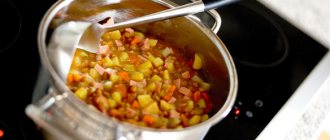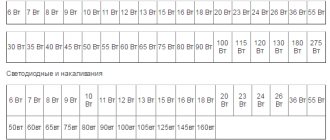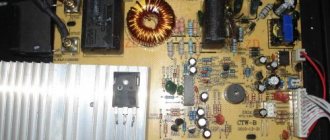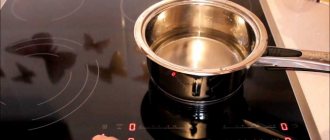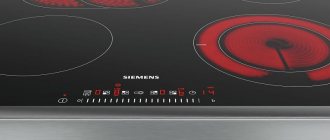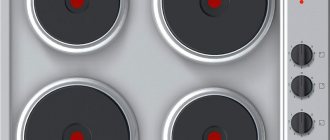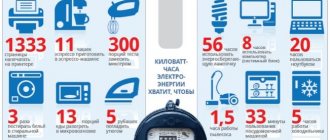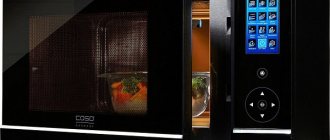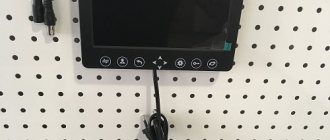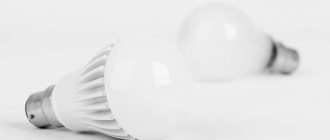How much electricity does an electric stove consume?
When purchasing an electric stove, consumers pay attention not only to the functionality of the product, but also to how much electricity will be consumed during operation. Currently, almost all manufacturers of household appliances have developed special stickers containing information about electricity consumption.
How is energy consumption determined?
Electricity consumption by an electric stove depends on the type of electric stove, classic or induction type. Electricity consumption is also affected by the saturation of the stove with functions and heating elements.
To calculate the electricity consumption of an electric stove, you need to know the power of the burners and the time allotted for operation.
A classic electric stove with conventional heating elements (tubular electric heaters) with a power of 2 kW in 15 minutes will consume energy from the electrical network equal to 2 kW ⋅ 0.25 h = 0.5 kW/h. Considering that the price for 1 kWh varies across Russian regions, the average value will be 4 rubles. That will turn out to be 0.5 kW/h x 4 rubles. = 2 rubles - the cost of operating an electric stove for 15 minutes.
By testing and the values of the passport characteristics, you can find out how much electricity an induction-type electric stove consumes. The Endever IP-11 induction hob is used as an example. Having a 2 kW burner, in 15 minutes of operation the stove will consume the same amount of electricity as a classic one. But there is a significant advantage: due to the absence of heat flow leakage past the dishes, the efficiency increases to 90%, and accordingly, the operating time of the stove decreases. Another plus in favor of saving energy is that when you remove dishes from the stove, the hob automatically turns off.
Testing the electricity consumption of classic and induction stoves
Both stoves are four-burner, with a power of 3.5 kW. A container with 2 liters of water is heated. In the first case, the pan is an ordinary 5 liter, without a lid, in the second case, the cookware for induction cookers is also 5 liters, and also without a lid. The initial water temperature is 21 o C.
Classic stove - water boiled in half an hour,
3.5 x 30 min /60 min = 1.75 kW/h.
Induction cooker, boiling time was 5.5 minutes,
3.5 x 5.5 min /60 min = 0.32 kW/h.
The second measurement will be the operating time of the burner.
In 15 minutes, the average electricity consumption of an induction cooker will be 0.175 kW/h, the total energy consumption is 0.5 kW/h.
In a classic stove for 15 minutes, the same 0.175 kW/h, but the energy consumption will be 1.93 kW/h,
Costs of an induction cooker.
- Energy consumption will be: 0.5 kW,
- hourly consumption - 1.3 kW,
- burners – 4 pieces,
- work for 2 hours a day,
- number of days in a year - 365
- 0.5 x 1.3 x 4 x 2x365=1890 kW
- 1890 kW x 4 rubles for 1 kW = 7592 rubles. in a year.
Per month for 30 days the amount will be 156 kW x 4 = 624 rubles.
Classic type stove.
- energy costs will be -1.93 kW
- hourly consumption - 1.3 kW
- burners – 4pcs
- opening hours per day - 2 days
- days a year - 365
- 1.93 x 1.3 x 4 x 2 x 365=7362 kW
- 7362 kW x 4 rub. =29305 rub. in a year.
For a month: 463 kW x 4 = 1852 rubles.
An induction cooker is an analogue of classic cookers with various additional advantages.
You can use your own values in this calculation, because it is not necessary that the stove will work 2 hours a day, or that all 4 burners will be used, and the cost per 1 kW/hour is different in each region.
Electricity consumption of classic stove burners.
For 1 hour of operation, a classic electric stove, depending on the position of the power adjustment knobs, consumes electricity.
A burner with a diameter of 145 mm, 1 kW in the 1st position consumes 0.10 kW, 2nd floor. – 0.17 kW, 3 poles -0.25 kW, 4 poles -0.50 kW, 5 poles – 0.75 kW, 6 floors -1 kW
A burner with a diameter of 180 mm, 1.5 kW in the 1st position consumes 0.14 kW, 2nd floor. – 0.22 kW, 3 poles -0.30 kW, 4 poles -0.85 kW, 5 poles – 1.2
It is impossible to imagine a modern apartment or house without a kitchen stove. However, when choosing the main assistant in cooking, it is not so easy to figure out which one is right for you.
Burner performance
Modern electric cooking panels have different power levels. Most devices have a power ranging from 3 to 10 kW, and it depends on the number of circles and their individual performance.
- In traditional appliances, the smallest burner usually consumes 0.4 to 1 kW of electrical energy per hour, and is intended for cooking food in small dishes. On such a surface it is convenient to brew coffee, prepare dishes for children or stew small portions of meat.
- Many modern models are equipped with rapid heating circles. More often they are called SuperQuick, Hi-Light or “express burners”. They have the highest power, which, depending on the type of model, can vary from 1.5 to 3 kW. Such circles are intended for quickly heating water in deep containers, cooking soup for a large family and frying large portions of meat.
- The next category of burners is represented by samples of average performance and a power of 1.5 kW. As a rule, these are the most frequently used circles, which bear the main load. They are used for boiling, frying and stewing dishes for a family of 3-4 people.
After doing the arithmetic calculations, you can see that the total power of a standard 4-burner hob with two medium-power circles, one heavy-duty and one low-power hob is 7 kW. The largest models, equipped with six burners, already have a higher power, reaching 10 kW. However, this indicator is valid only for panels of classical design. More advanced samples have an additional heating ring located around the main disk. It is clear that this design increases electricity consumption, however, it allows you to expand the heating area and use larger containers.
Operating principle and power consumption
Any of us understands how an electric or gas stove works. With induction everything is not so clear. This kitchen unit went on sale relatively recently, and there are still many household myths around it.
How does an induction cooker work?
The induction surface cooks using electromagnetic induction. This physical phenomenon allows metal utensils to be heated by eddy currents.
The hotplate only turns on if a suitable pan is placed on it. And turns off as soon as it becomes empty. Copper coils are located under the electronically controlled glass-ceramic panel.
Energy consumption
When buying equipment for your home, the first thing you should think about is saving energy. The energy consumption of induction and electric cookers is approximately the same. The average value is about 7 kilowatts per hour. This figure may vary depending on the number of burners and their size. However, an induction panel heats the same volume of water five times faster than a heating element electric stove of the same power.
In addition, the induction hob stops heating as soon as you remove the dishes and does not heat itself or the air around it. Having assessed these factors, we can say that the induction model is much more economical than the electric one.
Possibility of power adjustment
The power of the induction cooker is adjusted by sequential switching on and off. During cooking, the power can be changed. Also in some models it is possible to set the required heating temperature on the control panel.
Cooking surfaces: characteristics, types, types
— Gas control. A safety system that automatically stops the gas supply if the flame accidentally goes out. It consists of two main elements: a thermocouple and a gas blocking device. When the flame goes out, the thermocouple sends a signal to the blocking device, which shuts off the gas supply, preventing its leakage. — Auto-ignition. Gas burner ignition system built directly into the hob. Most often, auto-ignition uses an electric spark, and the device requires a network connection, even if all the burners on the surface are gas. On the other hand, this function greatly simplifies ignition, allowing you to do without matches, lighters and other sources of open flame. It is worth saying that auto-ignition systems can work in different ways: in some models the ignition is triggered immediately when you turn the knob that opens the gas, in others you need to press a separate button for this.
— Automatic shutdown. A system that allows you to automatically turn off the heating if necessary. The specific format of the automatic shutdown may vary: in some models it is triggered by a timer set by the user (see below), in others - when the burner reaches a critical temperature or if the heater has been operating for a long time without user intervention. Details for each model should be clarified separately. However, in any case, this function makes using the hob more convenient, if not safer. Note that automatic shutdown is almost never found in gas burners for technical reasons.
— Timer. A device that counts a certain period of time (specified by the user) and gives a signal at the end of the countdown. In addition, the timer can also provide automatic heating shutdown (see above). Specific types of timers vary - from the simplest mechanical pens to electronic units with displays. The first option is cheaper, but the error in such a device can reach several minutes; electronic devices are more expensive, but much more accurate and visual. Be that as it may, the presence of a timer can significantly simplify the user’s life, relieving him of the need to keep track of the time himself.
— Pause mode. The ability to “pause” all working burners with one press of a button, and then resume their operation by pressing the same button. In pause mode, the burners are actually switched off, and heating continues only due to residual heat; and when the pause is turned off, all previously set operating settings are returned - power, timer countdown, etc. This feature can come in handy when you need to leave the kitchen for a while - especially if the dish you are preparing could burn or “run away” at any moment, and you are not sure how long your absence will last. Note that the pause mode usually has a time limit of several minutes, after which the surface turns off completely.
- Child protection. The ability to lock the control panel of the device so that turning knobs and pressing buttons does not affect its operating mode (often, when the lock is turned on, the knobs are generally fixed in a stationary position). This function is useful primarily as protection against children: a curious child will not be able to turn on the hob or change its operating mode at his discretion. The lock is usually removed in such a way that an adult, but not a child, can do it - for example, by pressing buttons in a certain order.
— Residual heat indicator. An indicator indicating that the burner is still hot. As a rule, it responds to heating from 50 °C and above. The main purpose of such an indicator is to prevent burns from touching a hotplate that has not yet cooled down. It can also be used when turning on the burner to determine whether it is hot or not. This function is especially relevant for cast iron burners (see above), although it can also be useful for Hi-Light heaters.
— Autofocus. A system that adjusts the size of the working area of the burner to the size of the bottom of the cookware placed on it. Found exclusively in induction heaters (see above). Thanks to autofocus, the burner provides efficient heating of the entire bottom without wasting extra energy.
— Bridge mode. A function that allows you to combine two (or more) adjacent electric burners into one heater. Most often, this mode is found in induction burners, less often in Hi-Light, and in gas burners it is not used at all. Often the “bridge” looks like one continuous heater of an elongated shape, the individual parts of which can be turned on independently and are actually burners. Be that as it may, this mode can be useful primarily for working with elongated dishes - for example, casserole dishes. In addition, the design may provide various additional functions - for example, the ability to set different power settings for different parts of the “bridge” and move dishes between them depending on the readiness of the dish. In this case, unlike conventional burners, the heating will turn on automatically, depending on the presence of dishes on the burner.
— Built-in hood. The presence of its own built-in hood in the design of the hob. As a rule, the air intake is located at the level of the burners, its size is small, and its performance is low. Accordingly, a built-in hood is unlikely to be suitable as the main ventilation system in the kitchen, but at the same time it can be a good addition to a separately installed hood. The main disadvantages of hobs with this function are the high cost and complexity of installation.
— Hood control. Possibility of controlling the kitchen hood from the hob. To do this, both devices are synchronized via one or another communication channel, the hood turns on when the burner on the hob is turned on and adjusts the operating power depending on how many burners are working and at what power. This eliminates the need for the user to manually turn the hood on and off; and control parameters, as a rule, are selected in such a way that there is enough power even for the most difficult situations. Some models even allow you to adjust the specific performance of the hood in a given situation. True, it is worth noting that different manufacturers of kitchen appliances use different technologies for communication, which differ even in the principle of operation: for example, [email protected] Miele’s Ctivity operates via radio communication, and Electrolux’s Hob2Hood operates via an IR channel. Therefore, if you plan to use this function, you should pay special attention to the compatibility of the surface and the hood; and for maximum guarantee, you should choose among devices from one manufacturer.
— Management via the Internet. Ability to control the hob via the Internet. To connect to the network, the built-in Wi-Fi module is usually used, and the control method itself can be different: in some models you need to install a proprietary application on your smartphone or tablet, in others it is enough to open a special page in any browser. Be that as it may, this function allows you to control the hob and monitor its condition from anywhere in the world where there is Internet. In this way, you can, for example, leave a kettle on the burner and turn on the heating in advance on the way home, so that hot water is ready when you return. And if you go on a long trip, you can check at any time whether you forgot to turn off the stove, and, if necessary, correct the situation. However, it is worth considering that such functionality significantly affects the cost.
Pros and cons of an induction cooker
To finally decide whether it is worth buying an induction cooker, you need to consider all its pros and cons.
Advantages:
- Economical. An induction cooker heats the cookware directly. Heating occurs very quickly. There is no loss of thermal energy to heating elements and air. It turns off immediately when you remove the dishes. All this together leads to significant energy savings.
- Safety. The hob cools down almost instantly, making it impossible to get burned on it. This is very important for those who have small children.
- Easy to clean. Since the panel itself remains cool, food does not stick to it. Any dirt can be easily removed with a damp cloth. This property also protects against the unpleasant smell of burning.
- More possibilities . Induction cookers are equipped with a large number of programs by adjusting power and temperature. This makes the cooking process very convenient.
Flaws:
- Special dishes. Induction cooking requires pots and pans made of ferromagnetic material. In principle, this can be any container that attracts a magnet, but when using non-specialized dishes, the device may not work correctly or produce an unpleasant hum if the bottom of the pan is uneven.
- Magnetic radiation. The strength of electromagnetic radiation generated by the stove affects humans and other devices. In general, this is not as dangerous as it might seem. However, it is not recommended to install induction appliances at a distance of less than 50 cm from other electrical appliances. People with pacemakers are prohibited from cooking on this stove. Near the induction panel, bank cards may become demagnetized and mobile phones may be damaged.
- Price and repair. The choice of induction cookers is much smaller than that of heating elements, and their price is higher. Repairing a panel with a coil is also more expensive, and there are much fewer craftsmen capable of performing it.
Electricity consumption
An induction hob burner consumes an average of 1.5 kW of electricity per hour. Water in a five-liter saucepan boils in 6 minutes. To cook pasta, you will need to boil water and cook for 10 minutes.
This is exactly the amount of electricity needed to cook pasta on an electromagnetic stove:
- 10 min. + 6 min. = 16 min.;
- 1.5 kW/h: 60 min. = 0.025 kW/min;
- 16 min. x 0.025 kW/min. = 0.4 kW.
The price per kW of electricity in the central region of Russia averages 4 rubles.
Let's sum it up
As you can see, cooking on an induction cooker is beneficial. Comparing power consumption parameters gives more advantages to an induction cooker. Low energy costs with rapid heating are also recognized as an undeniable advantage of tiles.
Based on the described parameters of the induction cooker, a description of its pros and cons, as well as calculations of energy consumption, it will be easier for you to decide whether to purchase one model or another.
The power of an induction hob is the very point that is worth finding out before purchasing an electrical appliance. Most full-size models of this technology put forward quite serious requirements for network connection. But in terms of their indicators - speed of cooking, level of energy saving - they are superior to all other options.
A distinctive feature of induction heating is its high efficiency - up to 90%. Upon contact with the panel, predominantly the bottom and lower part of the cookware are heated, and heat transfer is directed directly to the food.
In this case, there are no irrational heat losses or risks of overheating of the surface of the glass-ceramic base itself.
Power range
The power of an induction hob is calculated in kilowatts (kW). This indicator is relevant for any electrical appliances. Modern manufacturers produce induction equipment in the following power categories:
- up to 3.5 kW, adapted for installation in standard houses and apartments;
- up to 7 kW, designed for connection to a dedicated 380 volt network;
- up to 10 kW - they are installed mainly in large country houses and have the highest energy consumption.
When purchasing induction equipment, you should definitely check the wired elements in your home. A weak cable can melt from heat; insufficiently reliable connections will lead to an increased fire hazard. If necessary, replace the wiring for the equipment with a suitable one, focusing on power.
Power of hobs and panels
Induction hobs come in different sizes and shapes. At the same time, the burners operate with unequal power and their functionality differs:
- a small burner (1000 W) is used for slow cooking of foods (porridge, meat, etc.);
- medium (from 1500 to 2500 W) is intended for preparing soups and side dishes;
- large and powerful (up to 3000 W) heat dishes up to +500°C, so it is optimal to use them for preparing large quantities of food in large containers.
Electricity consumption of induction-type cooking surfaces depends on the number of operating burners. The more powerful the device, the higher the performance of the stove. High power allows you to cook food faster, thereby reducing energy consumption.
Important! When purchasing an induction hob, consider the condition of the electrical wiring in the house. It is dangerous to connect powerful electrical appliances to old wiring.
Manufacturers of these slabs, unusual for Russian consumers, produce panels of 3 types of power:
- small - up to 3.5 kW;
- medium - from 3.5 to 7.0 kW;
- large - from 7.0 to 10.0 kW.
What determines energy consumption?
Electricity consumption of induction hobs primarily depends on the number of burners and their total performance. Uneven sizes of heating elements and their different configurations are needed in order to ensure ease of use of kitchen equipment in different heating modes. The energy consumption of an induction hob implies both alternating and simultaneous use of its individual elements. The most economical solution is the use of original double burners - they determine the required size of the heating field and activate it for operation.
Heating elements of the smallest diameter have a power of no more than 1 kW and are used for simmering, that is, for slow cooking of dishes. Medium-sized burners consume from 1.5 to 2.5 kW and are used to create side dishes, soups, and meat. The largest and most powerful 3 kW burners are needed to heat large pans to temperatures of 500 degrees Celsius.
Rating of the TOP 10 best electric hobs for 3 burners in 2021
| Place | Name | Price |
| TOP 5 best built-in 3-burner electric hobs in price/quality ratio | ||
| 1 | Kuppersberg ECS 402 | Find out the price |
| 2 | Beko HIC 63401 T | Find out the price |
| 3 | Schaub Lorenz SLK MY4630 | Find out the price |
| 4 | Zigmund & Shtain CNS 139.45 BX | Find out the price |
| 5 | LEX EVH 430 BL | Find out the price |
| TOP 5 best 3-burner electric cooktops with glass ceramics | ||
| 1 | Weissgauff HV 430 BS | Find out the price |
| 2 | Korting HK 42031 BW | Find out the price |
| 3 | Candy CH 63 CT | Find out the price |
| 4 | Korting HK 42031 B | Find out the price |
| 5 | MAUNFELD EVCE.453.D-BK | Find out the price |
What characteristics are important?
When choosing electric stoves, the most important thing to consider is the required number of burners for the family. You should not chase a large number of burners. For an average family of up to five people, it is usually sufficient to have a stove with one double burner and two separate burners of different sizes and power. Individual heating of the circuit allows you to control energy consumption. For a family of three, it will be enough to have a stove with just two burners of different power.
Before choosing a hob based on power, it is worth considering that options may increase the energy consumption of the electrical appliance. Built-in touch screen or temperature control from the remote control, other functionality also consumes electric current. The level of the brand also matters - the largest companies have their own ways of reducing energy consumption. For example, the use of boosters or even distribution of power across all burners.
The durability of ceramics and protection from electric shock also mean a lot. For cheap Chinese “no-name” stoves, the service life of the cooking surfaces is usually not comparable with the cost of purchasing them.
Criteria for choosing an economical stove
When starting to choose an induction electric furnace, they begin by determining the number of burners. Some approximate calculations will help you get your bearings:
- for a family of 5 people or more, models with 4 burners are suitable; the total power of such an electric hob is about 7 kW;
- for a family of 3-4 people it is convenient to use 3 burners;
- For a couple without children or one person, a stove with 2 burners is enough.
When choosing, pay attention to the functional equipment of the device, because each additional option increases energy consumption. Therefore, before purchasing, it is important to consider whether a touch screen, PowerBoost express heating and other additional features will be needed.
It is better to choose a device with energy-saving modes and protection against electric shock.
How much electricity is consumed per month
Calculating energy consumption, which all owners of houses and apartments have to pay once a month, becomes significantly more complicated if they have an electric stove. It is almost impossible to separately calculate exactly how much an induction hob will spend. But there are average standards that determine this figure at 1.3 kW/hour when all four burners are operating at a rated power of 3.5 kW. Daily use of cooking equipment for a total volume of at least 2 hours will require payment of 2.6 kW per day. About 78 kW will be consumed per month.
Induction hob
The power of the induction panel is approximately 7 kW. The induction surface copes with cooking food in the shortest possible time. Therefore, in extremely rare cases, all burners on an induction stove can be used at the same time.
Induction hob
A state-of-the-art induction cooker costs much more than its counterparts and you will have to buy special cookware for it. Therefore, before giving preference to this type of hob, you need to think about whether this technological innovation is worth such expenses and whether they will be justified.
The peculiarity and main advantage of such a hob is that it heats the bottom of the cookware, and not the air around it, which significantly saves energy consumption.
What influences the choice
You can choose the right built-in hob with induction characteristics, taking into account not only energy consumption, but also many other characteristics:
- number of heating points - there can be from one to four, it all depends on the size of the kitchen and the frequency of cooking;
- sizes of induction coils - they determine the diameter of the burners;
- connection to the network - for an ordinary apartment, a low-power device operating from a 220-volt household outlet will be sufficient, but for a home it is better to install a 380-volt line;
- design type - dependent or independent, the first of which is mounted only in conjunction with the oven;
- the presence of an edging that prevents cracking or destruction of fragile glass.
Taking into account all these factors, choosing the optimal kitchen equipment in terms of power will not be difficult. Induction cookers have fairly high energy consumption requirements. Large burners consume at least 2 kW/hour. Accordingly, for an apartment or private house with a maximum network load limit of 5 kW, you need to select equipment that does not exceed these power limits.
